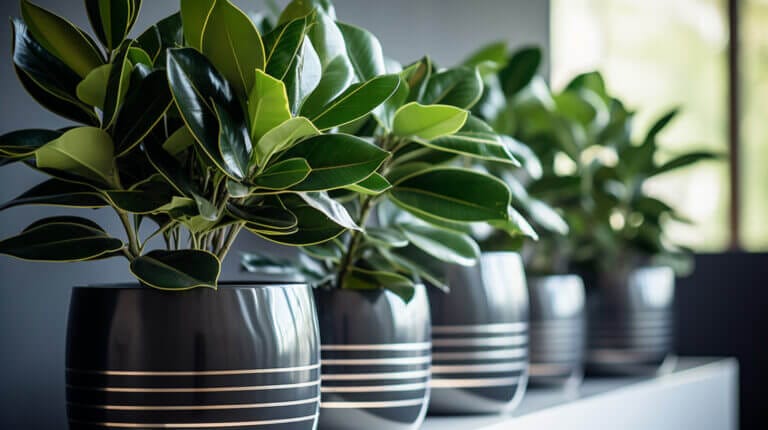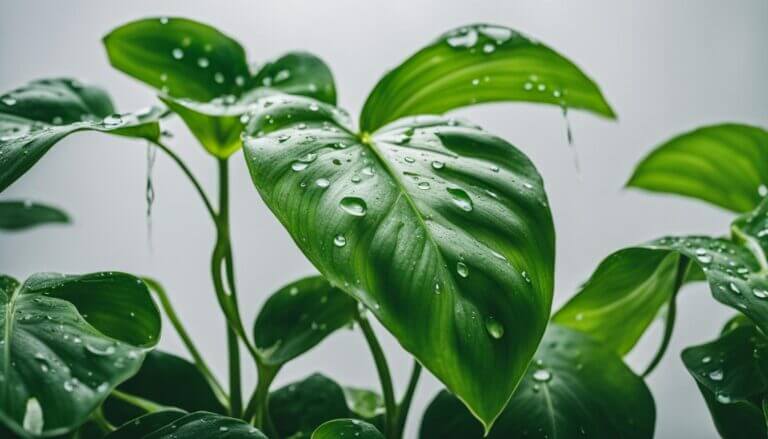How Often to Water ZZ Plant? Tips for Water A ZZ Plant(Zamioculcas Zamiifolia) Correctly
Key Takeaways
- ZZ plants prefer to be slightly underwatered rather than overwatered.
- Observe growth patterns and adjust watering based on the season.
- Signs of overwatering include yellowing leaves, wilting or drooping leaves, foul odor, mushy or discolored roots, and mold or fungus growth.
- Monitor soil moisture and adjust watering frequency based on climate and humidity levels.
Understanding the ZZ Plant’s Water Requirements
Interestingly, understanding the proper way to water ZZ plant is crucial for maintaining its optimal health and growth. Proper watering techniques are essential to prevent over-watering or under-watering, which can lead to root rot or dehydration. To ensure the well-being of your ZZ plant, here are some important watering tips and common mistakes to avoid.
Firstly, it’s important to know that ZZ plants are drought-tolerant and prefer to be slightly underwatered rather than overwatered. They store water in their rhizomes, which act as water reservoirs. Therefore, it is best to let the soil dry out between waterings. A good rule of thumb is to water needs of your ZZ plant when the top inch of soil feels dry to the touch.
When watering, it’s crucial to avoid excessive moisture. If ZZ plant is overwatered, it can suffocate the roots and lead to root rot. To prevent this, make sure to use well-draining soil and a pot with drainage holes. Additionally, it’s recommended to water the plant from the bottom by placing it in a tray of water and allowing it to soak up the moisture for about 15 minutes. Any excess water should be discarded to avoid standing water.
On the other hand, under-watering can also harm your ZZ plant. Signs of under-watering include yellowing leaves and wilting. To prevent this, ensure that you need to water during each watering session, allowing the water to reach the plant’s roots. Be sure the pot & soil mix has good drainage, allowing water to flow on the bottom of the pots to avoid water logging to prevent root rot.
Determining the Right Watering Schedule for Your ZZ Plant
To determine the right zz plant watering schedule for your ZZ plant, it is important to observe its growth patterns and monitor the moisture levels in the soil regularly. Adequate drainage is crucial for the proper watering of ZZ plants. These plants prefer to be slightly dry between waterings, so it is important to ensure that the pot has drainage holes to prevent water from sitting in the bottom and causing root rot.
The frequency of watering a ZZ plant should be adjusted based on the season. During the active growing season, which is typically spring and summer, the ZZ plant may require more frequent watering as it actively absorbs water and nutrients. As the weather cools down in autumn and winter, the plant’s growth slows down, and watering should be decreased accordingly to prevent overwatering and root rot.
In addition to observing growth patterns and adjusting watering based on the season, it is important to pay attention to the moisture levels in the soil. ZZ plants prefer to be watered when the top inch of soil has dried out. Insert your finger into the soil to test its moisture level. If it feels dry, it’s time to water. However, if it still feels moist, it’s best to wait a little longer.
Signs of Overwatered ZZ Plant and How to Avoid It
During the active growing season of spring and summer, it is crucial to be aware of the signs of overwatering your ZZ plant and take necessary steps to prevent it. Overwatering is one of the most common mistakes made by plant enthusiasts, and it can lead to root rot and ultimately the death of the plant. To help you avoid this, here are some signs of overwatering to look out for:
| Signs of Overwatering | How to Prevent |
|---|---|
| Yellowing leaves | Water the ZZ plant only when the top inch of soil is dry. |
| Wilting or drooping leaves | Ensure proper drainage by using a well-draining potting mix and a pot with drainage holes. |
| Foul odor | Avoid using saucers to collect excess water and empty any standing water in the saucer promptly. |
| Mushy or discolored roots | Use a moisture meter or your finger to check the soil moisture level before watering. |
| Mold or fungus growth | Adjust watering frequency and the right amount of water is based on the plant’s needs and the environmental conditions. |
Recognizing the Signs of Underwatered ZZ Plant
Inadequate watering and the signs of a lack of water can lead to the stunted growth and yellowing of leaves in your ZZ plant. Understanding the growth patterns and needs of your ZZ plant is crucial in preventing these issues and maintaining its health. Here are four important points to consider:
- Monitor soil moisture: ZZ plants prefer slightly dry conditions, so allowing the soil to dry out partially between waterings is essential. Stick your finger about an inch into the soil to check for moisture. If it feels dry, it’s time to water.
- Adjust watering frequency: ZZ plants generally require watering every 2-3 weeks, depending on the climate and humidity levels. However, adjusting this frequency based on the plant’s specific needs is important. Keep an eye on the plant’s growth rate and adjust watering accordingly.
- Avoid overwatering: Overwatering can lead to root rot, one of the most common issues with ZZ plants. Ensure that the pot has proper drainage and avoid leaving stagnant water in the saucer or tray. Allow excess water to drain completely.
- Provide adequate humidity: ZZ plants prefer moderate humidity levels. You can place a tray of water near the plant or use a humidifier to increase humidity.
Best Practices for Watering Your ZZ Plant Correctly
The key to maintaining the health of your ZZ plant lies in implementing best practices, such as using the correct watering techniques and adhering to a consistent watering schedule.
The ZZ plant, also known as Zamioculcas zamiifolia, is a popular choice for indoor plants due to its resilience and low-maintenance nature. However, improper watering can lead to root rot and other issues that can harm the plant.
When it comes to how often to water a ZZ plant, it is important to strike the right balance. Overwatering can lead to root rot, while underwatering can cause the leaves to yellow and wilt. The general rule of thumb is to water your ZZ plant when the top two inches of the soil are dry. This can vary depending on factors such as the temperature, humidity, and the size of the pot.
It is also important to avoid letting your ZZ plant sit in water for extended periods of time. Make sure to use a well-draining potting mix and a pot with drainage holes to prevent water from pooling.
In addition to frequency, the way you water your ZZ plant is crucial. Instead of pouring water directly onto the leaves, aim for the soil around the base of the plant. This will help prevent any moisture-related diseases.
Frequently Asked Questions
Should I Repot My ZZ Plant Before or After Watering It?
When deciding whether to repot your ZZ plant before or after watering it, following some tips for repotting zz plants can be helpful. One key tip is to water the plant a day or two before repotting to make the soil easier to work with. This ensures that the plant’s roots are well-hydrated before the process. Additionally, repotting after watering can help minimize stress on the plant.
Can I Mist Instead of ZZ Plant Watering It From the Roots?
Misting vs. root watering is a common question when it comes to the care of ZZ plants.
While misting can provide some hydration to the leaves, it is not sufficient to keep the plant properly hydrated.
ZZ plants have thick, fleshy roots that are designed to store water, and watering from the roots ensures that the water reaches these storage organs.
Misting alone may lead to inadequate hydration, potentially affecting the growth and overall health of the plant.
How much water does a ZZ plant need?
ZZ plants are known for their ability to thrive with little water. They need just enough water to keep the soil moist, but not too much as to waterlog the plant. Keep in mind water only when the soil feels a bit dry before watering. In winter, the ZZ plant will need less water compared to summer.
How Often to Water ZZ Plant?
To decide how often do you water a ZZ plant depends on various factors such as the size of the plant, the pot it’s in, and the environment. However, a good rule of thumb is to water your plant every 7-14 days.
What happens if you overwater a ZZ plant?
Overwatered ZZ plants can suffer from root rot, which can lead to yellowing leaves and a general decline in plant health. If you think your plant has been overwatered, reduce watering and ensure the pot has drainage holes at the bottom.
How do you know when a ZZ Plant needs water?
ZZ plants will let you know when they need water. The leaves may start to droop or yellow, indicating that the plant needs more water.
Can a ZZ plant survive without water?
While ZZ plants are drought-tolerant and can survive periods without water, they do need some moisture to thrive. If left without water for too long, the plant may become underwatered and show signs of stress.
What’s the best way to water a ZZ plant?
The best way to water a ZZ plant is by bottom watering. This method ensures that the roots get enough water without over-saturating the soil.
How much and how often should I water my ZZ plant?
The amount of water and frequency depend on the size of your ZZ plant and its environment. Generally, watering every 7-14 days with enough water to moisten the soil is sufficient.
Can I use tap water to water my ZZ plant?
Yes, you can use tap water to water your ZZ plant. However, if your tap water is hard or contains high levels of chlorine, it may be better to use filtered or distilled water.
How do I keep my ZZ plant healthy?
To keep your ZZ plant healthy, provide it with enough light, maintain a consistent watering schedule, and ensure it’s planted in well-draining soil.
What should I do if my ZZ plant is underwatered?
If your ZZ plant is underwatered, increase your watering frequency slightly or provide a bit more water at each watering. Monitor your plant closely for improvements in its condition.
How often do you water a ZZ plant indoor?
Determining how often you should water a ZZ plant, it can vary depending on the environment, such as season and the size of the plant. However, a good rule of thumb you most likely need to water your ZZ plant once a week. This ensures that the plant receives the right amount of water it needs to thriveWhen deciding whether to repot yourwater-a-zz-plant-pro-tips-for-watering-correctly”>How Often to Water ZZ Plant? Tips for Water A ZZ Plant(Zamioculcas Zamiifolia) Correctly
Key Takeaways
- ZZ plants prefer to be slightly underwatered rather than overwatered.
- Observe growth patterns and adjust watering based on the season.
- Signs of overwatering include yellowing leaves, wilting or drooping leaves, foul odor, mushy or discolored roots, and mold or fungus growth.
- Monitor soil moisture and adjust watering frequency based on climate and humidity levels.
Understanding the ZZ Plant’s Water Requirements
Interestingly, understanding the proper way to water ZZ plant is crucial for maintaining its optimal health and growth. Proper watering techniques are essential to prevent over-watering or under-watering, which can lead to root rot or dehydration. To ensure the well-being of your ZZ plant, here are some important watering tips and common mistakes to avoid.
Firstly, it’s important to know that ZZ plants are drought-tolerant and prefer to be slightly underwatered rather than overwatered. They store water in their rhizomes, which act as water reservoirs. Therefore, it is best to let the soil dry out between waterings. A good rule of thumb is to water needs of your ZZ plant when the top inch of soil feels dry to the touch.
When watering, it’s crucial to avoid excessive moisture. If ZZ plant is overwatered, it can suffocate the roots and lead to root rot. To prevent this, make sure to use well-draining soil and a pot with drainage holes. Additionally, it’s recommended to water the plant from the bottom by placing it in a tray of water and allowing it to soak up the moisture for about 15 minutes. Any excess water should be discarded to avoid standing water.
On the other hand, under-watering can also harm your ZZ plant. Signs of under-watering include yellowing leaves and wilting. To prevent this, ensure that you need to water during each watering session, allowing the water to reach the plant’s roots. Be sure the pot & soil mix has good drainage, allowing water to flow on the bottom of the pots to avoid water logging to prevent root rot.
Determining the Right Watering Schedule for Your ZZ Plant
To determine the right zz plant watering schedule for your ZZ plant, it is important to observe its growth patterns and monitor the moisture levels in the soil regularly. Adequate drainage is crucial for the proper watering of ZZ plants. These plants prefer to be slightly dry between waterings, so it is important to ensure that the pot has drainage holes to prevent water from sitting in the bottom and causing root rot.
The frequency of watering a ZZ plant should be adjusted based on the season. During the active growing season, which is typically spring and summer, the ZZ plant may require more frequent watering as it actively absorbs water and nutrients. As the weather cools down in autumn and winter, the plant’s growth slows down, and watering should be decreased accordingly to prevent overwatering and root rot.
In addition to observing growth patterns and adjusting watering based on the season, it is important to pay attention to the moisture levels in the soil. ZZ plants prefer to be watered when the top inch of soil has dried out. Insert your finger into the soil to test its moisture level. If it feels dry, it’s time to water. However, if it still feels moist, it’s best to wait a little longer.
Signs of Overwatered ZZ Plant and How to Avoid It
During the active growing season of spring and summer, it is crucial to be aware of the signs of overwatering your ZZ plant and take necessary steps to prevent it. Overwatering is one of the most common mistakes made by plant enthusiasts, and it can lead to root rot and ultimately the death of the plant. To help you avoid this, here are some signs of overwatering to look out for:
| Signs of Overwatering | How to Prevent |
|---|---|
| Yellowing leaves | Water the ZZ plant only when the top inch of soil is dry. |
| Wilting or drooping leaves | Ensure proper drainage by using a well-draining potting mix and a pot with drainage holes. |
| Foul odor | Avoid using saucers to collect excess water and empty any standing water in the saucer promptly. |
| Mushy or discolored roots | Use a moisture meter or your finger to check the soil moisture level before watering. |
| Mold or fungus growth | Adjust watering frequency and the right amount of water is based on the plant’s needs and the environmental conditions. |
Recognizing the Signs of Underwatered ZZ Plant
Inadequate watering and the signs of a lack of water can lead to the stunted growth and yellowing of leaves in your ZZ plant. Understanding the growth patterns and needs of your ZZ plant is crucial in preventing these issues and maintaining its health. Here are four important points to consider:
- Monitor soil moisture: ZZ plants prefer slightly dry conditions, so allowing the soil to dry out partially between waterings is essential. Stick your finger about an inch into the soil to check for moisture. If it feels dry, it’s time to water.
- Adjust watering frequency: ZZ plants generally require watering every 2-3 weeks, depending on the climate and humidity levels. However, adjusting this frequency based on the plant’s specific needs is important. Keep an eye on the plant’s growth rate and adjust watering accordingly.
- Avoid overwatering: Overwatering can lead to root rot, one of the most common issues with ZZ plants. Ensure that the pot has proper drainage and avoid leaving stagnant water in the saucer or tray. Allow excess water to drain completely.
- Provide adequate humidity: ZZ plants prefer moderate humidity levels. You can place a tray of water near the plant or use a humidifier to increase humidity.
Best Practices for Watering Your ZZ Plant Correctly
The key to maintaining the health of your ZZ plant lies in implementing best practices, such as using the correct watering techniques and adhering to a consistent watering schedule.
The ZZ plant, also known as Zamioculcas zamiifolia, is a popular choice for indoor plants due to its resilience and low-maintenance nature. However, improper watering can lead to root rot and other issues that can harm the plant.
When it comes to how often to water a ZZ plant, it is important to strike the right balance. Overwatering can lead to root rot, while underwatering can cause the leaves to yellow and wilt. The general rule of thumb is to water your ZZ plant when the top two inches of the soil are dry. This can vary depending on factors such as the temperature, humidity, and the size of the pot.
It is also important to avoid letting your ZZ plant sit in water for extended periods of time. Make sure to use a well-draining potting mix and a pot with drainage holes to prevent water from pooling.
In addition to frequency, the way you water your ZZ plant is crucial. Instead of pouring water directly onto the leaves, aim for the soil around the base of the plant. This will help prevent any moisture-related diseases.
Frequently Asked Questions
Should I Repot My ZZ Plant Before or After Watering It?
When deciding whether to repot your ZZ plant before or after watering it, following some tips for repotting zz plants can be helpful. One key tip is to water the plant a day or two before repotting to make the soil easier to work with. This ensures that the plant’s roots are well-hydrated before the process. Additionally, repotting after watering can help minimize stress on the plant.
Can I Mist Instead of ZZ Plant Watering It From the Roots?
Misting vs. root watering is a common question when it comes to the care of ZZ plants.
While misting can provide some hydration to the leaves, it is not sufficient to keep the plant properly hydrated.
ZZ plants have thick, fleshy roots that are designed to store water, and watering from the roots ensures that the water reaches these storage organs.
Misting alone may lead to inadequate hydration, potentially affecting the growth and overall health of the plant.
How much water does a ZZ plant need?
ZZ plants are known for their ability to thrive with little water. They need just enough water to keep the soil moist, but not too much as to waterlog the plant. Keep in mind water only when the soil feels a bit dry before watering. In winter, the ZZ plant will need less water compared to summer.
How Often to Water ZZ Plant?
To decide how often do you water a ZZ plant depends on various factors such as the size of the plant, the pot it’s in, and the environment. However, a good rule of thumb is to water your plant every 7-14 days.
What happens if you overwater a ZZ plant?
Overwatered ZZ plants can suffer from root rot, which can lead to yellowing leaves and a general decline in plant health. If you think your plant has been overwatered, reduce watering and ensure the pot has drainage holes at the bottom.
How do you know when a ZZ Plant needs water?
ZZ plants will let you know when they need water. The leaves may start to droop or yellow, indicating that the plant needs more water.
Can a ZZ plant survive without water?
While ZZ plants are drought-tolerant and can survive periods without water, they do need some moisture to thrive. If left without water for too long, the plant may become underwatered and show signs of stress.
What’s the best way to water a ZZ plant?
The best way to water a ZZ plant is by bottom watering. This method ensures that the roots get enough water without over-saturating the soil.
How much and how often should I water my ZZ plant?
The amount of water and frequency depend on the size of your ZZ plant and its environment. Generally, watering every 7-14 days with enough water to moisten the soil is sufficient.
Can I use tap water to water my ZZ plant?
Yes, you can use tap water to water your ZZ plant. However, if your tap water is hard or contains high levels of chlorine, it may be better to use filtered or distilled water.
How do I keep my ZZ plant healthy?
To keep your ZZ plant healthy, provide it with enough light, maintain a consistent watering schedule, and ensure it’s planted in well-draining soil.
What should I do if my ZZ plant is underwatered?
If your ZZ plant is underwatered, increase your watering frequency slightly or provide a bit more water at each watering. Monitor your plant closely for improvements in its condition.
How often do you water a ZZ plant indoor?
Determining how often you should water a ZZ plant, it can vary depending on the environment, such as season and the size of the plant. However, a good rule of thumb you most likely need to water your ZZ plant once a week. This ensures that the plant receives the right amount of water it needs to thrive.







